The Brain
The brain was a mystery for a very long time.
Modern imaging has allowed us to study the brain and locate where important functions are occurring.
Remember that the functions do not happen in just one area of the brain. Many neural layers and areas are found in any one activity that happens.
But what we do know is that some areas do appear to be predominantly involved in certain functions.
We will learn about the brain in the three-part model. We'll first look at the hindbrain. The hindbrain is located where the spinal cord goes into the cranium and includes the cerebellum, medulla, and the pons.
The cerebellum is located behind the spinal cord and helps with posture and balance.
The medulla controls breathing, heart rate, and swallowing while the pons functions as a bridge between the spinal cord and the brain.
The hindbrain is a bridge taking our sensory information to the cortex to be interpreted.
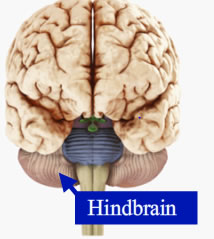
The image is a diagram of the brain with an arrow pointing to the hindbrain, which is the lower back part of the brain on each side of the spinal cord.
The second part of the brain is the midbrain.
The midbrain takes all of the incoming neural information and channels it to the correct part of the cortex to be interpreted.
It is also involved in muscle tone and helps in sleep, wakefulness and attention.

The image is a diagram of the brain with an arrow pointing to the midbrain, which is the lower back part of the brain just above and center of the hindbrain and the spinal cord.
The forebrain is the last part of the brain to be studied. It is the most complicated part of the brain, and it is what separates us as human beings from other animals.
It includes the thalamus, which is the relay station for all the information that travels to and from the cortex.
Just below the thalamus is the hypothalamus which controls hunger, thirst, and sexual behavior.
It also controls the body's reaction to changes in temperatures so that when we are hot, we sweat, and when we are cold, we shiver.
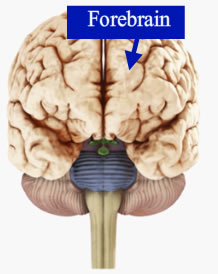
The image is a diagram of the brain with an arrow pointing to the forebrain, which is the area of the brain most people visualize when picturing a human brain.
When we first look inside the skull, what we see is the cerebrum.
The cerebrum is composed of two parts called hemispheres.
One is on the right side and one is on the left side.
The outer covering of the cerebrum is called the cortex.
It is made up of what is called convolutions - the worm-like structures that you see when you look at the brain.
The Lobes
We can look at the cortex in another way and divide the cortex into four sections called lobes. The function of the lobe is to interpret information coming in from our senses.
Located in the back of the head is the occipital lobe. The occipital lobe processes visual information, or what we see.
Coming to the top of the head is the parietal lobe. The parietal lobe processes information on pain, touch, temperature and pressure.
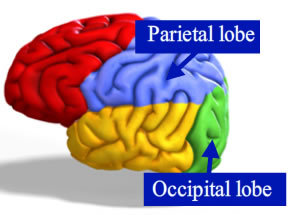
Located on the sides of our head, right above our ears, are the temporal lobes. The temporal lobe processes auditory information, emotion, and has a part in memory.
Located right above our forehead is our frontal lobe. It is the largest part of the Cortex and the part of our brain that makes us human. It is involved in speech production, logical and rational thought, and gives us the ability to understand and plan the future.
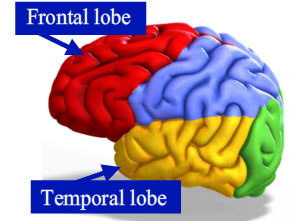
Go to Brain Line and view the presentation. Roll your cursor over the different parts of the brain to learn about each lobe.
The Hemispheres
The two hemispheres are located in the cortex and are almost identical in appearance with each of the four lobes present in both hemispheres.
The hemispheres are connected by a band of nerve fibers called the corpus callosum, which carries messages back and forth between the two hemispheres to jointly control human functions.
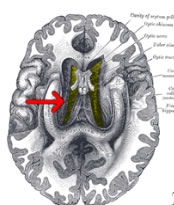
The image is a top-view diagram of the brain, pointing to the cortex in the center of the brain between the two hemispheres.
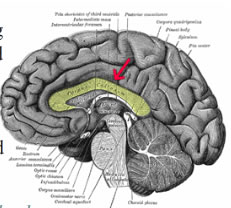
The image is a side-view diagram of the brain, pointing to the cortex in the center of the brain.
The left hemisphere controls the right side of the body and coordinates our language abilities.
The left side is also the logical, rational brain and excels in such areas as science and math.
The right hemisphere controls the left side of the body. It excels in spatial abilities. It is our artistic and musical part of our brain. It also has a function in detecting and emoting emotions.
 Photo Citation: U.S. National Institutes of Health. Corpus callosum. [Image]. Available at: http://www.nlm.nih.gov/medlineplus/ency/imagepages/8753.htm
Photo Citation: U.S. National Institutes of Health. Corpus callosum. [Image]. Available at: http://www.nlm.nih.gov/medlineplus/ency/imagepages/8753.htm
The image contains three diagrams of the brain, the first showing an image of the brain with the center area highlighted in pink, the second reflects an enlarged version of the pink area with arrrows pointing to the left and right hemispheres of the brain with a box around the cortex area, and the third has the box enlarged showing the corpus callosum.
Patients with severe epilepsy have allowed us to discover another important concept about our brains.
To help severe epileptics when drugs failed, a dramatic operation was performed and it involved cutting the corpus collosum.
As you remember, the corpus collosum is the band of nerve fibers that holds the hemispheres together.
Separating the hemispheres allows the seizures to be localized and not spread from one hemisphere to the other. The split-brain patient has taught us that the hemispheres have distinct, different functions.
In all but split-brain patients, we use all of our brains and both hemispheres since they communicate with each other.
The right hemisphere knows what is happening in the left hemisphere, and the left hemisphere knows what is going on in the right hemisphere.
They must adapt to that lack of communication but other than that, those who have had split-brain operations remained practically unchanged in intelligence, personality and emotions.
Go to Brain Basics and view the slideshow to learn about the different parts of the brain, what each part controls and how injury would affect it.